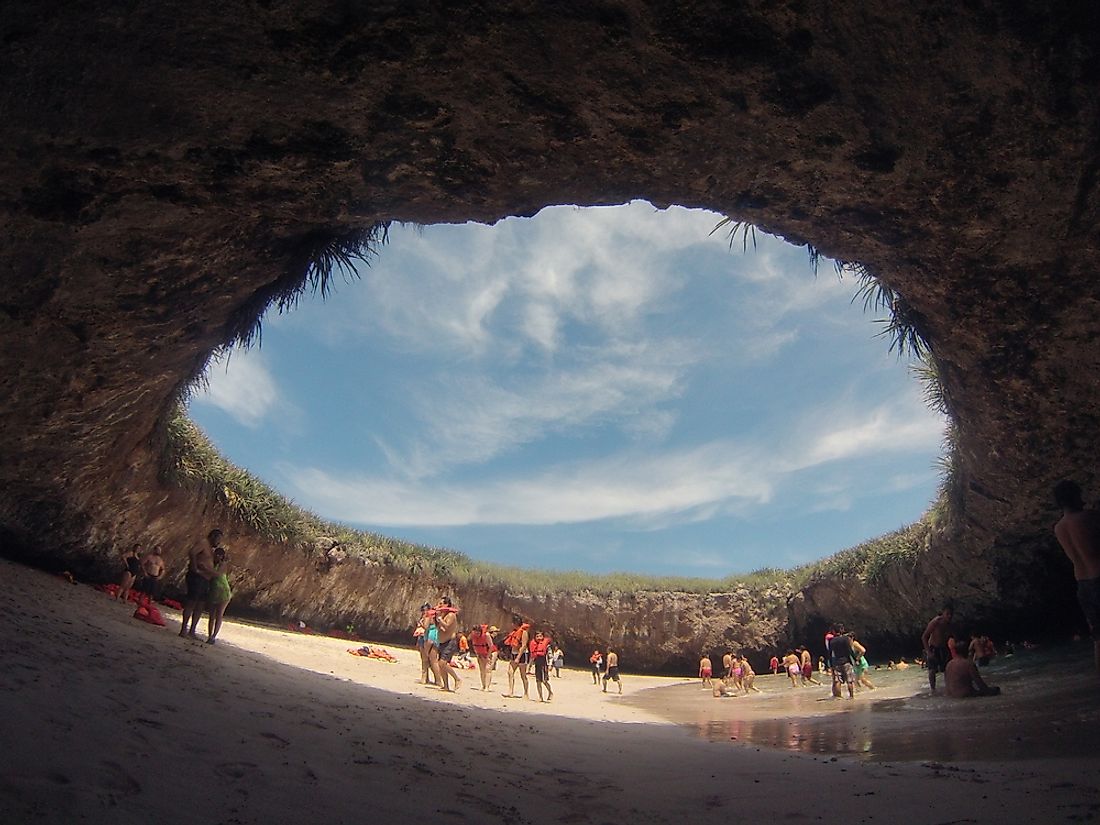The Hidden Beach of the Marieta Islands, Mexico

To English speakers, what is called la Playa del Amor is better known as the Hidden Beach of the Marietas Islands. The Marietas Islands are an archipelago, or a chain of islands, which were named a national park in 2005. Off the coast of the state of Nayarit and approximately 23 miles (37 kilometers) west of Puerto Vallarta, the Hidden Beach is an underground beach located inside a crater on one of the islands. The Hidden Beach gets its nickname from the fact that it is practically invisible except when viewed from above. The climate in the area is temperate, ranging from 70 to 90˚F (21 to 32˚C) throughout the year, making it a great tropical vacation destination.
4. Tourism
Although widely known now thanks to exposure on the Internet and social media, the Hidden Beach was for many years considered mostly untouched, as it is not easily accessible to the public. A boat is required to reach the islands, provided through group tours when the tide is high. The only way to get to the beach itself is to swim from boats over to it. For people visiting Puerto Vallarta, there are many tour groups that offer day trips to the Marietas Islands. It is not recommended that tourists charter their own boats or hire water taxis to get to the island, due to environmental, legal, and safety concerns.
3. Uniqueness
The Hidden Beach is only accessible through a 50-foot (15-meter) long tunnel. As it links the crater to the Pacific Ocean, it is always partially submerged and people can only go through it by swimming, kayaking, or scuba diving during low tides. It is believed that the Hidden Beach came to be in the early 1900s, when the Mexican government was using the Marietas Islands as a military testing site. The bombs that were detonated there have caused a number of other caves and craters on the islands as well. Having since recovered from its military testing days, it is now protected as a national park and a UNESCO Biosphere Reserve.
2. Habitat
The archipelago is also known as the “Galapagos of Mexico, as the wildlife refuge of the Marietas Islands has an extremely high level of biodiversity. It is the migration and breeding ground for more than 90 species of birds, including the endangered Blue-Footed Boobie. Aside from birdwatching, visitors can also snorkel or scuba dive and explore the 78 hectares of coral reefs that house over 100 species of fish, jellyfish, sharks, and rays. There are also a number of dolphins and whales that can be spotted in the waters around the islands. The Marietas Islands are also home to various reptiles, including iguanas, sea and land turtles, lizards, and rattlesnakes.
1. Threats
Trying to reach the Hidden Beach through the tunnel can prove to be dangerous to people, even when scuba diving, but reputable tour groups will take these concerns into account. The ecosystem was heavily damaged during the military tests, but has since then mostly bounced back. As a UNESCO Biosphere Reserve, the islands are now under the protection of the Mexican Government, and all visitors are required to receive permits before entering. In order to help conserve the islands’ ecosystems, visitors are also not supposed to interact with or disturb the wildlife, make loud noises, engage in extreme sports activities (including rock climbing), start any kind of fire, or litter.







